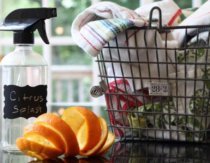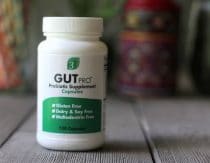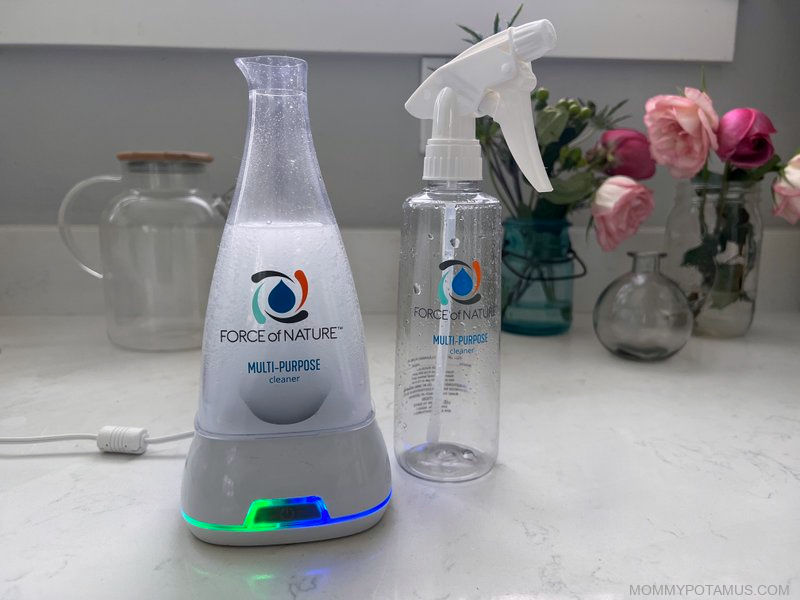
If your Instagram feed looks anything like mine, you’ve probably seen those Force of Nature ads claiming that a multi-purpose cleaner, disinfectant and deodorizer be made with nothing more than vinegar, water, salt and a cute little appliance.
As someone who has been making DIY cleaning supplies for many years now, I was both excited and skeptical. Would it clean effectively? Is the compound that’s made truly non-toxic? Can I really use it to replace 3-5 different cleaning products?
After some preliminary research, I ordered a starter kit along with a similar product from O3 Waterworks in order to test them against each other.
In this article I’ll dive into why many “natural” cleaners really aren’t, how Force of Nature is different, and what I think after using it for over a year.
Yep, Your “Natural” Cleaner May Still Contain Toxic Ingredients
You probably already know that cleaning product manufacturers aren’t required to disclose full ingredient lists on their labels, so a lot of companies hide toxic ingredients under vague descriptions like “fragrance” or “proprietary blend.”
That’s even true for many so-called “natural” or “eco-friendly” options, because there are no federal safety standards or criteria for what those terms mean. Companies can – AND OFTEN DO – add ingredients linked to hormone disruption, organ toxicity and neurotoxicity, and respiratory/skin irritation before slapping a leaf, lavender bud, or earth graphic on the label and shipping it to stores.
For example, this popular “natural” all-purpose cleaner gets a “D” from the Environmental Working Group for Safety because it contains harmful chemicals including methylisothiazolinone, which is linked to allergic reactions, lung toxicity and neurotoxicity. (1)
You know what also gets the exact same safety rating? This Lysol spray.
Unfortunately, even if labels were fully transparent, we still have a major problem – gaps in safety data. As I wrote about here, only about 20% of the 80,000 chemicals currently approved for use in the US have undergone any safety testing at all, and only 50-100 have been closely examined to determine their health effects. (2)(3)
Thanks to a 2016 law, the EPA is now required to study them, plus the roughly 2,000 new ones that get added every year. However, with the timetable they’ve been given it could take them literal centuries to complete their research. (4)
What We Know Right Now
We’ll dive into some specific ingredients worth avoiding later in this article, but first here’s the 10,000 foot view.
1. Research has shown that over the long term, using conventional cleaning products is as harmful to our bodies as smoking 20 cigarettes a day. (5)
2. Children are far more vulnerable to environmental toxins than adults. (6) Pound for pound, children breathe more air, drink more water, and eat more food than adults. (7)
It makes sense when you think about it – their respiratory, endocrine, and nervous systems are growing quickly, so they need more fuel. Unfortunately, exposing them to toxins during this vital developmental period can impair the normal function of these systems.
3. Unlike years ago when the only option was to make everything from scratch, there ARE companies that offer safe options. Force of Nature is one of them.
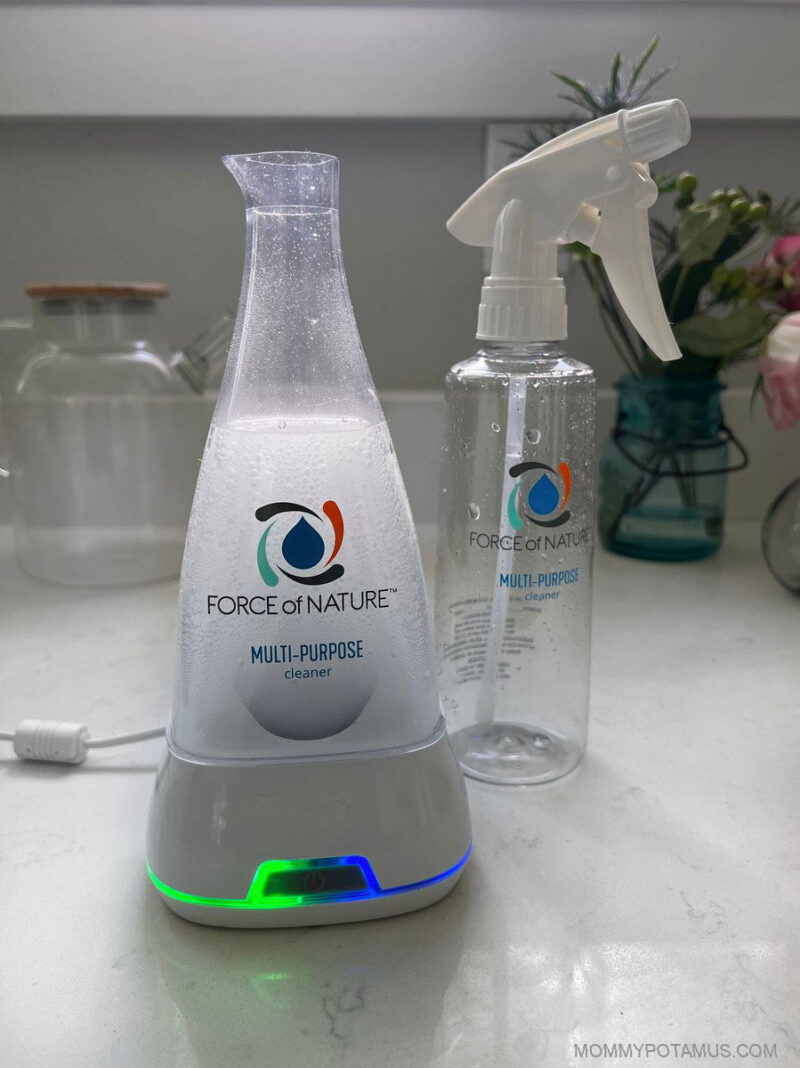
So, what’s in Force of Nature’s Cleaner?
The fact that I am even able to answer this question makes Force of Nature unique. Their ingredient list is 100% complete and transparent – no sneaky labeling practices or proprietary formulas – just:
- Water
- Salt
- Vinegar
Using a countertop electrolyzer, the molecules in salt and water are broken apart so that they can form two new active ingredients:
Hypochlorous acid
Our white blood cells actually make this acid to defend against pathogens. It’s powerful enough to be used in industrial settings and hospitals to kill bacteria, viruses, mold and mildew.
At the same time, because it’s part of our immune system it’s not harmful to us. In fact, it’s used therapeutically in wound healing, eye care and veterinary products.
Sodium hydroxide
If you’ve ever made my pure coconut oil soap, you may recognize this ingredient as the catalyst that transforms fats and oils into soap via saponification. In this cleaner, it acts as a mild detergent that dissolves grease, grime and soap scum.
The concentration is very gentle – just .0000003%. Most all-purpose cleaners have concentration levels between 1-5%.
Although the vinegar doesn’t directly create either ingredient, it adjusts the pH in order to create the right conditions for them to form.
Is it really effective?
Yes, it’s an EPA registered disinfectant that kills 99.9% of viruses and bacteria, even Staph, MRSA, Norovirus, Influenza A, Salmonella, Pseudomonas and Listeria when used as directed. As I mentioned above, it’s actually been used to disinfect hospitals for a long time, but until recently the technology wasn’t available to make this cleaner at home.
Unlike harsh cleaners, though, it gets the safest rating possible from the Mayo Clinic’s Skin Safety database.
How does it work?
The process is super simple:
- Pour tap water into the electrolyzer bottle until it reaches the fill line,.
- Plug it in.
- Add the activator capsule and wait 10 seconds for the salt and vinegar to disperse.
- Press the button to start electrolysis.
- When the light shifts from blue to green the cleaning solution is ready. Pour it into the reusable Force of Nature spray bottle that comes with your kit (or a their optional glass spray bottle) and rinse the electrolyzer container. That’s it!
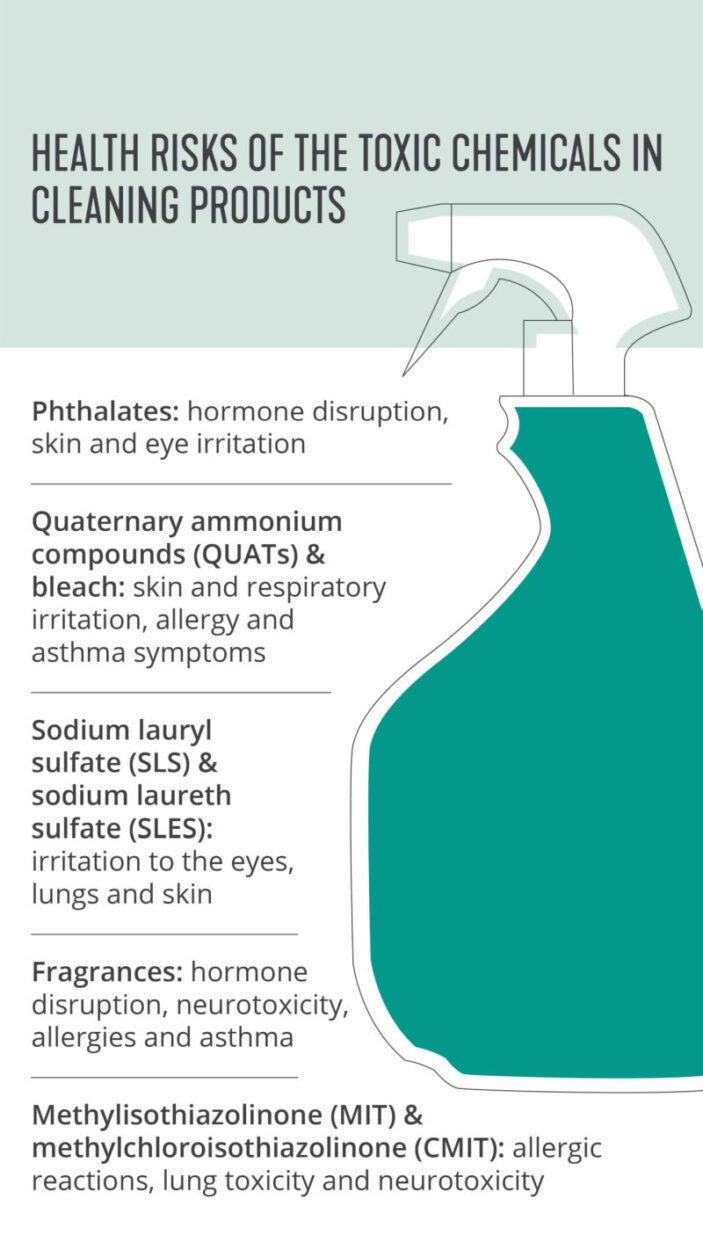
What’s NOT In Force of Nature’s Cleaner
You’re probably already familiar with the health risks of bleach and ammonia, but other common problematic cleaning product ingredients to be aware of include:
Quaternary ammonium compounds (QUATs). These compounds come with a wide range of health risks including the triggering or worsening asthma, disruption of vital cellular processes, and reproductive and developmental harm in animals. (8)(9) According to Scientific American:
Mice exposed to disinfectants in commercial-grade cleaning products took longer to get pregnant, had fewer pups and suffered more miscarriages and distressed fetuses.” Sadly, no one has checked to see if quats cause reproductive harm in humans – it’s one of the 80,000+ chemicals currently approved without sufficient safety studies.
Preservatives like methylisothiazolinone (MIT) and methylchloroisothiazolinone (CMIT), which are linked to allergic reactions, lung toxicity and neurotoxicity. (1) MIT, CMIT and other isothiazolinones are also added to many paints . . . even ones labeled as Zero-VOC.
Up until recently they weren’t disclosed anywhere by major paint brands – not even on the Safety Data Sheet – but due to increasing restrictions on their use they may are more likely to be listed on the SDS.
Synthetic dyes don’t improve the performance of cleaning products but do increase their health risks. (10)
Sodium lauryl sulfate (SLS) and sodium laureth sulfate (SLES) are surfactants that can irritate skin and are often contaminated with carcinogenic 1,4-dioxane. (11)
Fragrance, which is an umbrella term for undisclosed chemicals, can include carcinogens, phthalates, neurotoxins, and eye/skin/lung irritants. (12)
Ethanolamine compounds including diethanolamine (DEA) have been linked to fertility problems, organ toxicity and possible neurotoxicity. (13) (14) It’s banned from use in personal products in the European Union due to concerns that it may act as a carcinogen. (15)
Pros
- Versatility & Effectiveness
- Cost Effective
- Pet-friendly
- Non-Toxic
- No Mold Concerns
- More Eco-Friendly
Cons
- 2 Week Shelf Life Per Batch
- Not Totally Zero Waste
Force of Nature Pros
Versatility & Effectiveness – Can replace everything from conventional Windex and Formula 409 to Scrubbing Bubbles and Febreze, and it works.
Cost – There is an upfront cost to purchase the electrolyzer (see below for a coupon code), but the ongoing cost of making each bottle of cleaner is up to 80% less than what you’ll find on store shelves. (About ten cents per ounce.)
Pet-friendly – Formulas that contain essential oils are not generally safe for use around cats, and we adopted two indoor kitties a few years ago.
Non-Toxic – Free from fragrances, phthalates, dyes, preservatives, surfactants, bleach, quats, and other problematic ingredients that are associated with hormone disruption, respiratory issues and more.
No Mold Concerns – I learned the hard way that if the O3 Waterworks reservoir is not cleaned diligently it can develop mold. It was definitely due to user error – the care instructions do say to clean it – but I just got busy and forgot. Fortunately, due to the way it’s designed, the Force of Nature electrolyzer is not vulnerable to the same issue.
More Eco-Friendly – Their system completely eliminates single-use plastic bottles, so you can reduce your plastic waste by 97%. Their recyclable Activator Capsules also take up a lot less storage space than bulky plastic bottles, so you can fit a whole year’s worth of cleaning solution into a tiny box.
Force of Nature is also Green Seal and Carbon Neutral certified for environmental sustainability.
Force of Nature Cons
Each batch has a shelf life of 2 weeks, which is why it’s been used by hospitals that have the capability to make it on demand but has never been mass produced for sale in stores.
However, with the Force of Nature electrolyzer bottle you can you make perfectly sized batches at home with the press of a button, making it super convenient, highly effective solution.
I always use a full bottle in two weeks, but if you’re concerned about how to track that there are a few options:
- Rinse out the electrolyzer and plug it back in. Even while empty, it will display a green light that will turn yellow when the cleaner needs to be swapped out.
- Set a reminder on your calendar to make a new batch in two weeks.
- Use an erasable chalk pen to write the expiration date on the bottom of the spray bottle.
If you have any leftover at the two week mark, it’s completely safe to just pour down the drain.
Not totally zero waste – Although the activator capsules are recyclable, most plastic doesn’t get recycled in the United States even when it’s theoretically possible. With that said, it’s one of the lowest waste options I’ve found. Even DIY formulations require purchasing raw materials, often in plastic packaging/containers.
Smells kind of like pool water – This is not necessarily a con, just something to be aware of. Hypochlorous acid (HOCl) is actually a type of chlorine, but it’s very different from the substance we know as bleach (sodium hypochlorite, or NaOCl).
Remember, our bodies actually make it to protect us.
Ways To Use Force of Nature Cleaner
- All-purpose cleaner – For kitchen and bathroom countertops, toilets, etc.
- Disinfectant – For cutting boards, forgotten lunch containers with food left inside, etc. I also use it to clean two shared nebulizer masks that my family uses when we have respiratory issues (congestion, stuffy nose, etc.)
- Window cleaner – It works just as well as this DIY streak-free option
- Soap scum remover – For sinks, tile, and tubs. Depending on how much build up there is, you may need a mild abrasive like baking soda with your scrub brush the first few times. This is because soap scum builds up in layers and can require a few applications to break down. I
- Oil and Grease Remover – According to independent lab testing, it works better than Formula 409 All Purpose Cleaner for removing oil and grease. I use it on my ceramic cooktop.
- Pet mess cleaner – We have one kitty that occasionally throws up if she eats too quickly, so we feed her multiple small meals instead of big ones. However, sometimes she steals our food and we find “surprises” on the floor. When that happens, Force of Nature makes cleanup super easy.
- Make fresh flowers last longer – Add a few ounces to a vase of water to keep them in bloom for as long as possible.
- Makeup brush cleaner – Rinse with water, spray generously with Force of Nature, then let air dry in the sun if possible.
- Trash can deodorizer – Wipe down the inside of trash cans between bag changes to keep them fresh.
Many people also use it to spot clean carpets and rugs (we don’t currently have either, although I am actively shopping for non-toxic washable rugs).
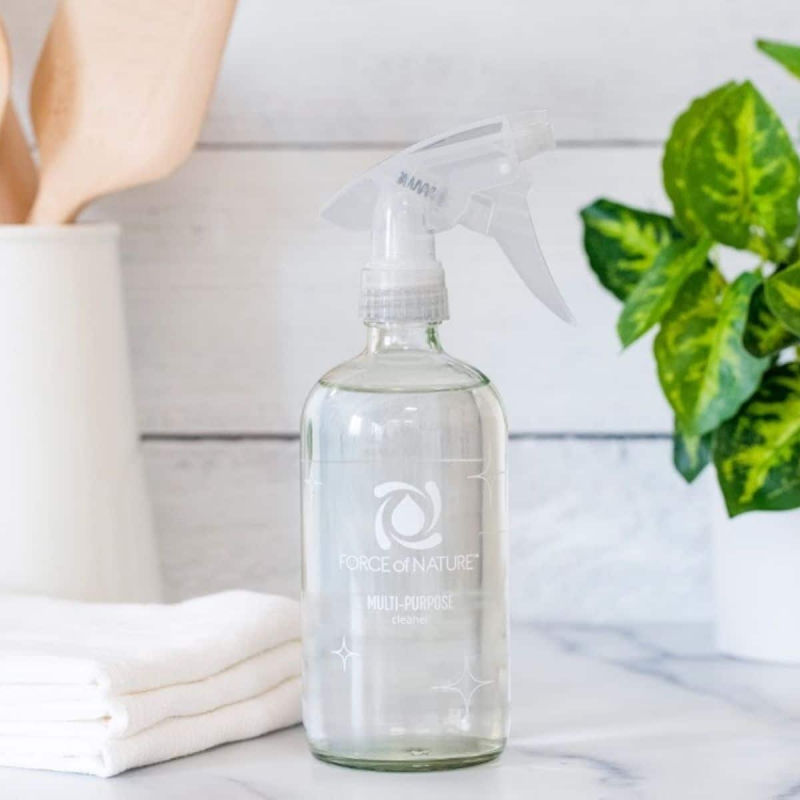
Final Thoughts + How To Save
Indoor environments don’t get the benefit of Nature’s best disinfectant – sunshine – so while I’m not afraid of germs, I do believe it’s important to strategically clean and disinfect certain areas in order to simulate natural ecological processes.
Force of Nature has become one of my favorite tools for implementing that approach. It’s super easy to use, cost effective, and truly non-toxic.
If you want to try them out, they offer a 30 day, 100% Happiness Guarantee. If you don’t love your system after you try it out, you can return it within 30 days for a full refund (minus the cost of return shipping).
Click here and use code MP40 get 40% off + free shipping on bundles
Frequently Asked Questions
Do I really have to use the capsules? Why can’t I just add salt and vinegar to the water?
As you may know, hydrogen peroxide and vinegar are effective disinfectants when used in tandem with each other – a process that involves two applications and wipe-downs. However, if you combine them they form a different compound called peracetic acid, which is harmful to humans.
That’s why understanding chemistry is really important, even when working with natural ingredients that are totally safe when used correctly.
When it comes to electrolyzed water, precision is equally important. Incorrect amounts can create bleach or a weak solution that doesn’t work effectively. For that reason, it’s important to use the precisely measured capsules that will create a potent but safe solution every time.
Why not just using cleaning vinegar or another DIY option?
Depending on what you are trying to accomplish and how many products you are willing to make, you can use DIY options.
For example, cleaning vinegar does remove grime, but it’s not a true disinfectant and is not safe for surfaces like marble or granite. So in some cases it may be a great option, and in others Force of Nature might be preferable.
Why isn’t Force of Nature rated by The Environmental Working Group?
The EWG doesn’t currently rate devices in their cleaning category, but hopefully they will in the future.
Sources
- Ataman Chemicals. Methylisothiazolinone
- The Atlantic (2014) The Toxins That Threaten Our Brains
- The Guardian (2019) Is modern life poisoning me? I took the tests to find out
- PBS (2016) It could take centuries for EPA to test all the unregulated chemicals under a new landmark bill
- Øistein Svanes et. al. (2018) Cleaning at Home and at Work in Relation to Lung Function Decline and Airway Obstruction
- Philip J Landrigan and Lynn R Goldman (2011) Children’s vulnerability to toxic chemicals: a challenge and opportunity to strengthen health and environmental policy
- Environmental Protection Agency. Human Health Risk Assessment.
- Judy S. LaKind and Michael Goodman (2019) Methodological evaluation of human research on asthmagenicity and occupational cleaning: a case study of quaternary ammonium compounds (“quats”)
- Ana V. Camagay et. al. (2023) Quaternary Ammonium Compound Toxicity
- Environmental Working Group. Announcing EWG’s Updated Guide to Healthy Cleaning, Spring 2016
- MadeSafe (2022) Chemical Profile: 1,4-dioxane
- Campaign for Safe Cosmetics. Fragrance.
- Panchal, S. R., and Verma, R. J. (2013) Spermatotoxic effect of diethanolamine: An in vitro study
- Gamer, A. O. et. al. (2008) The Inhalation toxicity of di-and triethanolamine upon repeated exposure
- Cosmetics Info. Diethanolamine and Diethanolamine Salts

